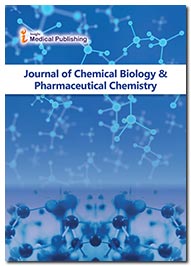ISSN : 2634-7814
Journal of Chemical Biology & Pharmaceutical Chemistry
Design and Development of Hybrid Molecules Targeting Multi-drug Resistant Bacteria
Alexandr Read*
Department of Chemical Biology, University of Cambridge, Cambridge, United Kingdom
*Corresponding author:
Alexandr Read,
Department of Chemical Biology, University of Cambridge, Cambridge, United Kingdom,
Email: a.read@cac.uk
Received date: 02 January, 2025; Accepted date: 18 January, 2025; Published date: 31 January, 2025.
Copyright: Mehta A (2025), This is an open-access article distributed under the terms of the creative commons attribution license which permits unrestricted use, distribution and reproduction in any medium, provided the original author and source are credited.
Citation: Read A (2025) Design and Development of Hybrid Molecules Targeting Multi-drug Resistant Bacteria. J Chem Biol Pharm Chem Vol. 8 No. 1: 01.
Introduction
The alarming rise of multi-drug resistant (MDR) bacteria has emerged as one of the most pressing global health crises of the 21st century. Antimicrobial resistance (AMR) has rendered many conventional antibiotics ineffective, leading to treatment failures, prolonged hospital stays, and increased mortality rates. Common pathogens such as Escherichia coli, Klebsiella pneumoniae, Staphylococcus aureus, and Pseudomonas aeruginosa have developed resistance mechanisms that diminish the efficacy of even last-resort drugs, including carbapenems and colistin. This escalating resistance crisis underscores the urgent need for innovative therapeutic strategies that move beyond traditional antibiotic discovery. One promising approach is the design and development of hybrid molecules, engineered by merging two or more pharmacophores into a single chemical entity to enhance antimicrobial efficacy and overcome resistance mechanisms [1].
Description
The concept of hybrid molecules in antimicrobial research is rooted in the idea of combining distinct modes of action within one molecule. Traditional antibiotic development has often focused on single-target inhibitors, which bacteria can adapt to relatively quickly through genetic mutations, efflux pumps, or enzymatic degradation. By integrating multiple pharmacophores, hybrid molecules can exert synergistic or additive effects, reducing the likelihood of resistance development. For example, combining a β-lactam core with a β-lactamase inhibitor in a single scaffold can simultaneously attack bacterial cell wall synthesis while neutralizing resistance enzymes. Hybridization also allows researchers to incorporate non-antibiotic pharmacophores, such as efflux pump inhibitors or membrane disruptors, thereby targeting multiple bacterial defense systems at once. This polypharmacological strategy enhances potency, reduces required dosage, and expands the antimicrobial spectrum [2].
Designing hybrid molecules requires careful consideration of pharmacodynamics, pharmacokinetics, and structural compatibility of the parent moieties. A successful hybrid molecule should retain the biological activity of both pharmacophores while ensuring chemical stability, solubility, and bioavailability. Advances in computational drug design and molecular docking have accelerated the rational development of such hybrids by predicting binding affinities and molecular interactions with bacterial targets. Moreover, synthetic chemistry techniques, such as click chemistry and multicomponent reactions, provide versatile tools for creating diverse hybrid libraries with minimal synthetic complexity. Importantly, hybrids can also be designed to minimize toxicity toward human cells while maximizing bacterial selectivity [3].
Several successful examples of hybrid molecules highlight the potential of this approach in combating MDR pathogens. Similarly, hybrid aminoglycosideâ??peptide constructs have shown effectiveness against Gram-negative bacteria, including carbapenem-resistant, by disrupting cell membranes and ribosomal function. Another promising avenue is the development of quinolone-antimicrobial peptide hybrids, which display broad-spectrum activity and lower susceptibility to efflux-mediated resistance. These examples illustrate how hybridization not only extends the lifespan of existing antibiotic classes but also generates novel therapeutic options that are more resilient against bacterial adaptation [4].
Despite the promise of hybrid molecules, several challenges remain in their development and clinical translation. Achieving optimal pharmacokinetic profiles is often complex, as combining pharmacophores may result in altered absorption, distribution, metabolism, and excretion properties. Additionally, synthesis of large and structurally complex hybrids can be resource-intensive, requiring significant investment in medicinal chemistry. Beyond technical hurdles, regulatory approval pathways for hybrids remain relatively undefined, which may delay clinical adoption. Nonetheless, ongoing research and preclinical trials provide strong evidence that these challenges are surmountable with the integration of advanced computational modeling, high-throughput screening, and structureâ??activity relationship (SAR) studies [5].
Conclusion
The design and development of hybrid molecules represent a cutting-edge strategy in the battle against multi-drug-resistant bacteria. By integrating multiple pharmacophores into a single scaffold, hybrid drugs leverage synergistic mechanisms of action to circumvent bacterial resistance, enhance efficacy, and broaden antimicrobial spectra. Although challenges in synthesis, pharmacokinetics, and clinical validation persist, continued innovation in computational design, synthetic chemistry, and drug development platforms offers significant potential to accelerate the translation of hybrids from bench to bedside. As the threat of antimicrobial resistance continues to grow, hybrid molecules may become a cornerstone of next-generation anti-infective therapies, safeguarding global health against the looming post-antibiotic era.
Acknowledgement
None.
Conflict of Interest
None.
References
- Potrykus K, Murphy H, Philippe N, Cashel, M. (2011). ppGpp is the major source of growth rate control in coli. Environ Microbiol 13: 563-575.
Google Scholar Cross Ref Indexed at
- Gaal T, Gourse RL (1990). Guanosine 3'-diphosphate 5'-diphosphate is not required for growth rate-dependent control of rRNA synthesis in Escherichia coli. Proc Natl Acad Sci87: 5533-5537.
Google Scholar Cross Ref Indexed at
- Sliwoski G, Kothiwale S, Meiler J, Lowe Jr EW (2014). Computational methods in drug discovery. Pharmacol Rev66: 334-395.
Google Scholar Cross Ref Indexed at
- Aberg A, Fernández-Vázquez J, Cabrer-Panes JD, Sánchez A, Balsalobre C (2009). Similar and divergent effects of ppGpp and DksA deficiencies on transcription in Escherichia coli. J Bacteriol191: 3226-3236.
Google Scholar Cross Ref Indexed at
- Shankarappa B, Sirko DA, Ehrlich, G. D. (1992). A general method for the identification of regions suitable for site-directed silent mutagenesis. Biotechniques12: 382-384.
Open Access Journals
- Aquaculture & Veterinary Science
- Chemistry & Chemical Sciences
- Clinical Sciences
- Engineering
- General Science
- Genetics & Molecular Biology
- Health Care & Nursing
- Immunology & Microbiology
- Materials Science
- Mathematics & Physics
- Medical Sciences
- Neurology & Psychiatry
- Oncology & Cancer Science
- Pharmaceutical Sciences
